High Level Summary of Statistics: Key Trends for Scotland 2006
Presents key trends for Scotland across all areas of governement activity.
4. Transport and Travel
Personal Travel
How People Travel
On average, Scots travelled 6,667 miles per person per year within Great Britain in the two-year period 2002/2003, according to the National Travel Survey ( NTS). The car was used as the main mode for over three-quarters of the distance travelled: 5,135 miles, of which 3,136 miles was covered as a driver and 1,999 miles as a passenger. (If more than one mode of transport is used during a journey, the "main mode" is that used for the longest stage).
There has been a large rise in the distance travelled, with most of the increase being due to travel by car. In 1985/1986, Scots travelled, on average, only 4,652 miles per person per year, of which only 3,227 miles was by car as the main mode. So, over about 17 years, the average distance travelled per person per year increased by 2,015 miles, of which 1,908 were by car.
Other NTS results for 2002/2003 include average distances travelled per Scottish resident per year of 356 miles by local bus as the main mode for the journey, 313 miles by surface rail, 191 miles by foot, 52 miles by taxi and 26 miles by bicycle.
The NTS covers travel within Great Britain for personal purposes. It excludes travel in the course of work to convey passengers or to deliver goods. Results are given for periods of two or three years because of the small sample size, and, even then, the figures for some modes may fluctuate due to sampling variability. As usual when reporting NTS results, figures for "car" include the relatively small amount of personal travel by van or by lorry.
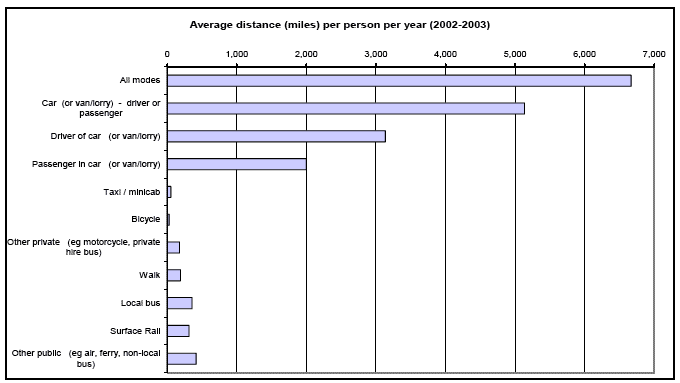
Source: Scottish Transport Statistics 2005 edition (Table 12.2) and Travel by Scottish residents, 2002 and 2003 (Table D)
Publications
Travel by Scottish residents: some NTS results (Published 2005)
Scottish Transport Statistics (Published 2005)
Reasons for Travel
On average, Scots made 991 trips per person per year, and travelled 6,667 miles per person per year, within Great Britain in the two-year period 2002/2003, according to the National Travel Survey ( NTS).
The most frequent purposes of trips were "other personal business or other escort" ( e.g. trips to/from banks, churches, doctors, hairdressers and libraries, and escorting someone other than to/from education) with, on average, 199 trips per person per year, shopping (192 trips per person per year), commuting (159) and visiting friends/relatives at home (117).
Commuting trips accounted for an average of 1,232 miles per person per year. (All averages "per person" include children and pensioners, so the average per commuter will be much higher.) The other main purposes were visiting friends/relatives at home (1,019 miles), other personal business or other escort (961 miles), shopping (902 miles), and holidays and day trips within GB (887 miles).
Since 1985/86, there has been little change in the average number of trips per person per year (it has fluctuated between 972 and 1,112, presumably due to sampling variability). However, the average distance travelled per person per year increased by 2,015 miles - from 4,652 miles in 1985/86 to 6,667 miles in 2002/2003 (with some period-to-period fluctuations attributable to sampling variability). The following purposes together accounted for most of the rise in the average distance travelled per person per year: "other personal business or other escort" (up 429 miles); shopping (up 361 miles); holidays and day trips (up 333 miles); visiting friends/relatives at home (up 254 miles) and commuting (up 252 miles).
The chart shows how the average length of trip has risen for the main purposes over the same period (again, there are some period-to-period fluctuations), and that the overall average length of trip rose from 4.8 miles to 6.7 miles.
The NTS covers travel within Great Britain for personal purposes. It excludes travel in the course of work to convey passengers or to deliver goods. Results are given for periods of two or three years because of the small sample size, and, even then, the figures for some purposes may fluctuate due to sampling variability.
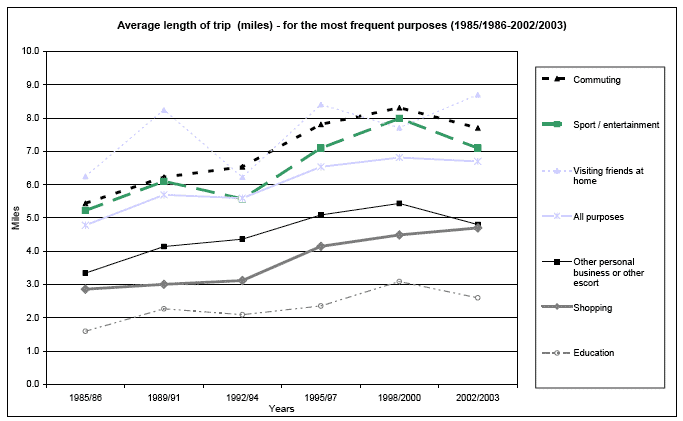
Source: Scottish Transport Statistics 2005 edition (Table 12.6) and Travel by Scottish residents … 2002 and 2003 (Table H3)
Publications
Travel by Scottish residents: some NTS results (Published 2005)
Scottish Transport Statistics (Published 2005)
Travel to work
Around two-thirds of people who travelled to work in 2004 did so by car (or van), 60% as the driver and 8% as a passenger, according to the Scottish Household Survey ( SHS). 13% took a bus, 13% walked, 3% went by train and 2% cycled. (People who work at or from home are not counted in these figures.)
Men were more likely to drive (63% against 56% for women); women were more likely to walk (16% against 9% for men) or go by bus (14% against 11% for men).
The percentage driving to work rose with the income of the household: from 39% for commuters from households with an annual net income of up to £10,000 to 72% of those from "over £40,000" households. The percentage walking fell from 26% in "up to £10,000" households to 9% in "over £40,000" households, and similarly the percentage using the bus dropped from 21% to 4%.
About three-quarters of commuters living in rural areas drove, and only 3-5% went by bus. Large urban areas and "remote" small towns had the lowest percentages driving to work (both 51%) and large urban areas had the highest percentage going by bus (19%).
Since the SHS started in 1999, the percentage driving to work seems to have risen and the percentages who walk or are a passenger in a car may have fallen. However, sampling variability may cause some apparent year-to-year fluctuations.
Census results show that, between 1966 and 2001, there was a large rise in the percentage who commute by car (up from 21% to 68%), and large falls in the percentages who use the bus (down from 43% to 12%) and who walk to work (down from 24% to 12%). Over the same period, there was little change in the percentages travelling to work by train and by bicycle, which remained around 3-4% and 1-2% respectively.
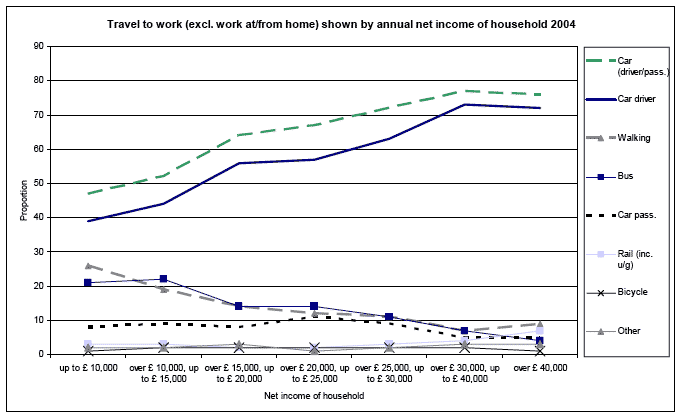
Source: Scottish Transport Statistics 2005 edition (Table 12.17) and Household Transport in 2004 (Table 15)
Publications
Travel by Scottish residents: some NTS results (Published 2005)
Scottish Transport Statistics (Published 2005)
Web link
Scottish Household Survey
Travel to School
In 2004, 51% of pupils walked to school, 24% went by bus and 22% by car, according to the Scottish Household Survey ( SHS). One per cent cycled, 1% went by train and 2% used other modes of transport.
Pupils aged 4-11 (broadly, primary school ages) were more likely to walk (58% against 42% for 12-18 year olds) or go by car (27% against 15%). Pupils aged 12-18 were more likely to go by bus (39% against 12%). The chart shows how the use of the different modes changes with age (the apparent year-to-year fluctuations may reflect sampling variability).
The percentage travelling by car rose with the income of the household: from 11% for pupils from households with an annual net income of up to £10,000 to 33% of those from "over £40,000" households. The percentage walking fell from 59% in "up to £10,000" households to 43% in "over £40,000" households; the percentage using the bus did not vary greatly with income.
Just under half of the pupils living in rural areas went by bus, and under a third walked. Fifty-six per cent of pupils in large urban areas walked to school, and only 17% went by bus. The percentage travelling by car did not vary much with the type of area.
Since the SHS started in 1999, the percentage of pupils travelling by car seems to have risen, the percentage who walk may have fallen and there has been little change in the use of the bus. Sampling variability may cause some apparent year-to-year fluctuations.
Over the longer term, the National Travel Survey ( NTS) shows that the percentage walking to school has fallen (it was around 69% in 1985/86), that travel by car has risen (from about 6% in 1985/86), and that there has been little change in the use of the bus.
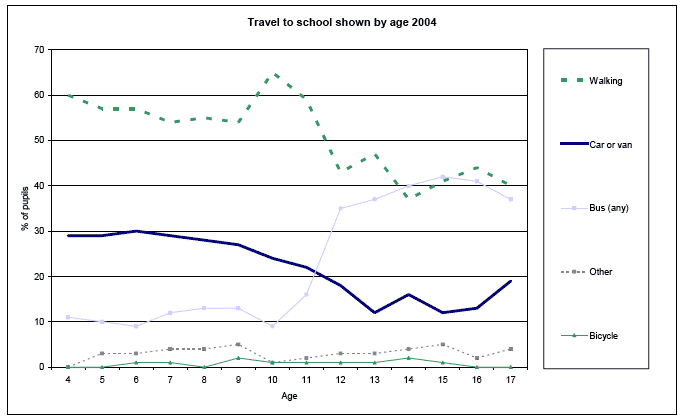
Source: More detailed version of figures from Scottish Transport Statistics 2005 edition (Table 12.18) and Household Transport in 2004 (Table 18)
Publications
Travel by Scottish residents: some NTS results (Published 2005)
Scottish Transport Statistics (Published 2005)
Web link
Scottish Household Survey
Private Transport
Motor Vehicles Licensed
The total number of motor vehicles licensed in Scotland reached a record level of over 2.4 million at the end of 2004. It has increased steadily over the years, with rises of 29% since 1994, 21% since 1997 and 15% since 1999. However, there were fewer vehicles per 100 population in Scotland (48) than in Great Britain as a whole (56) in 2004.
About 85% of all vehicles licenced in Scotland in 2004 were cars. Seven per cent were light goods vehicles, and motorcycles and heavy goods vehicles each accounted for about 2%. Twenty eight per cent of all vehicles licenced in 2004 ran on diesel, compared with 20% in 1996 (the first year for which such a figure is available).
There was a record number of new registrations of motor vehicles in Scotland in 2004: 263,000. Recent years show rises of 55% since 1994; 28% since 1997 and Twenty two per cent since 1999.
Eighty three per cent of new vehicles licenced in 2004 were cars. Forty per cent of all newly-registered vehicles ran on diesel, compared with 23% in 1999 (the first year for which such a figure is available).
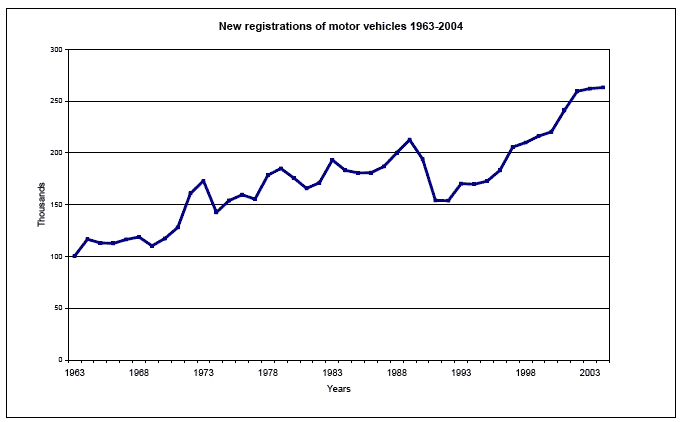
Source: Scottish Transport Statistics 2005 edition (Table H4)
Publication
Scottish Transport Statistics (Published 2005)
Household Car Availability
In 2004, 34% of households did not have a car normally available for private use, 43% had one car, 19% had two cars and 3% had three or more cars - so 66% of households had at least one car available for private use, according to the Scottish Household Survey ( SHS).
The chart shows how the availability of a car increased with the income of the household, from 35% for households with a net income of up to £10,000 per year, to 98% for those in "over £40,000" households. It also shows how the percentages with two or more cars, and with three or more cars, rose with income.
Around 83-84% of households in rural areas had at least one car, compared with only 56% of those in large urban areas.
The Scottish Household Survey shows that, since 1999, the percentage of households with one or more cars has risen from 63% to 66%, and that 2+ car households have increased from 18% to 23% (in both cases, with some apparent year-to-year fluctuations that are likely to be due to sampling variability).
The Department for Transport has combined the small Scottish samples of some GB surveys (like the National Travel Survey) to show the longer-term growth in the percentages of households with a car (from 51% in 1987 to 69% in 2003) and with 2+ cars (from 11% to 25%). It should be noted that the results of the SHS and the Scottish samples of GB surveys may differ slightly ( e.g.) due to sampling variability.
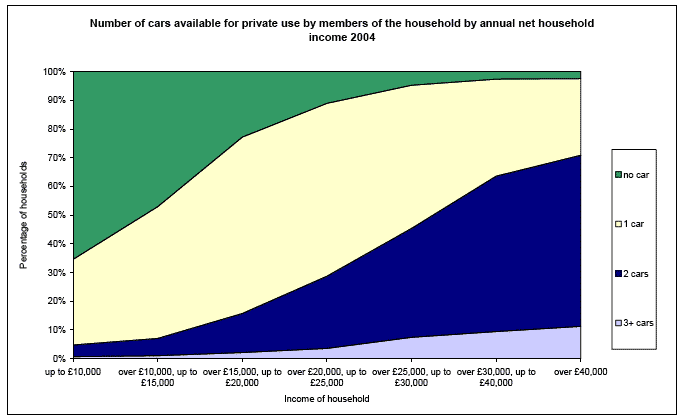
Source: Scottish Transport Statistics 2005 edition (more detailed version of figures appearing in Table 1.18) and Household Transport in 2004 (Table 1)
Publications
Household Transport: some SHS results (Published 2005)
Scottish Transport Statistics (Published 2005)
Web link
Scottish Household Survey
Driving Licence Possession and Frequency of Driving
In 2004, almost two-thirds (65%) of people aged 17+ had a full driving licence: 76% of men but only 57% of women, according to the Scottish Household Survey ( SHS). The percentage was highest (around 78%) for those aged 30-49. It was higher for men than for women for every age-group, as shown in the chart. Possession of a full driving licence increased with income, from 41% of people aged 17+ living in households with a net income of up to £10,000 per year, to 93% of those in "over £40,000" households. In rural areas, around four-fifths of people aged 17+ had a full driving licence, compared with under three-fifths in large urban areas.
The Scottish Household Survey shows that, since 1999, the percentage of 17+ year olds with a full driving licence has risen from 63%, with little change in the figure for men and an increase from 52% for women. The small Scottish part of the ( GB) National Travel Survey ( NTS) sample shows longer-term growth (from 49% in 1985/1986 to 67% in 2002/2003), due mainly to a large increase for women (from 34% to 58%), with the figure for men rising less rapidly (from 68% to 77%). It should be noted that SHS and NTS results differ slightly ( e.g.) due to sampling variability.
In 2004, 41% of people aged 17+ said that they drove every day: 48% of men and 35% of women. The percentage was highest (around 55%) for those aged 30-49. It was higher for men than for women for almost every age-group.
The percentage of people aged 17+ who drove every day increased with annual net household income, from 18% of those living in households with a net income of up to £10,000 per year, to 68% in "over £40,000" households. In rural areas, around half the people aged 17+ drove every day, compared with about a third in large urban areas.
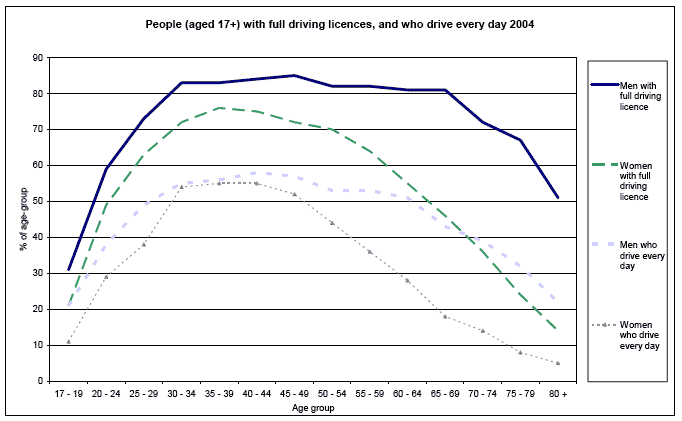
Source: more detailed version of figures appearing in Scottish Transport Statistics 2005 edition (Tables 1.16 and 12.10) and Household Transport in 2004 (Tables 2 and 3)
Publications
Household Transport: some SHS results (Published 2005)
Scottish Transport Statistics (Published 2005)
Travel by Scottish residents: some NTS results (Published 2005)
Web link
Scottish Household Survey
Car Occupancy
Most cars on the road have only one person in them: the driver. The Scottish Household Survey ( SHS) asks adults about their journeys on the day before the interview. In 2004, 60% of journeys which were made as the driver of a car were made unaccompanied, 27% were made with one passenger, 9% with two passengers, 4% with three passengers, and 1% with four or more passengers. As a result, the average number of people per car journey was 1.61.
The chart shows that car occupancy varied greatly with the purpose of the driver's journey. Eighty five per cent of car drivers who were commuting travelled alone, only 4% had three or more people in the car, and the average number of people in the car was only 1.20. Eighty three per cent of car driver journeys in the course of business were made unaccompanied, with an average car occupancy of 1.24. In contrast, of car drivers' journeys to eat or drink, or for a holiday or day trip, only 30-31% were unaccompanied, a third had three or more people in the car, and the average occupancy was about 2.2 people per car.
Car occupancy also varied with the start time and the day of the week of the journey. The driver was the sole occupant of the vehicle for 77% of car journeys starting before 7 a.m., and for 74% starting between 7 a.m. and 9.30 a.m., compared with 60% overall. The driver was unaccompanied in 64% of car drivers' journeys during the week, and 47% at weekends.
Car occupancy appears to have fallen since the SHS started in 1999. The proportion of journeys made as the driver of a car in which the person was unaccompanied has increased from about 55% to about 60%, and the average number of occupants for car journeys reported by the driver has decreased from 1.68 to 1.61.
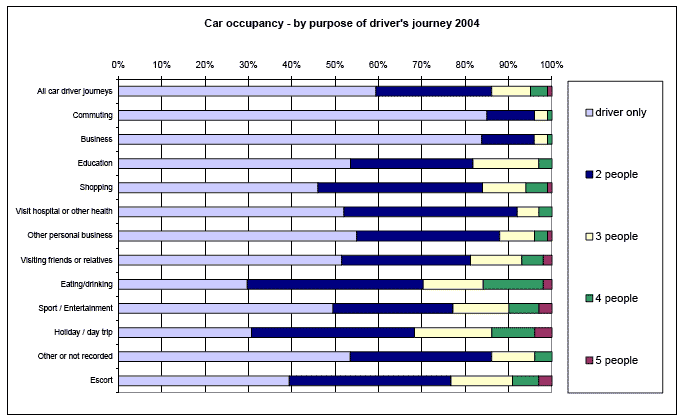
Source: Scottish Household Survey Travel Diary results for 2004 (Table 15)
Publication
Scottish Household Survey Travel Diary Results (Published 2006)
Web link
Scottish Household Survey
Walking and Cycling
The Scottish Household Survey asks adults whether, in the previous seven days, they walked more than a quarter of a mile in order to go somewhere ( e.g. to work, to the shops, or to visit friends). In 2004, 53% of adults had done so. The percentages for men and women were about the same. Adults aged 16-19 were the most likely to have walked to go somewhere, with over two-thirds reporting this, compared with only about half of those in their 50s and 60s, and one third of those aged 80+. The percentage did not vary much with household income.
The interviewer asks a similar question about walking for pleasure or to keep fit (including jogging and walking a dog). Forty-four said that they had done so (46% of men and 42% of women). The chart shows how the percentage varies with sex and age. Walking for pleasure or to keep fit tended to rise with household income.
Similar information is collected about cycling. Three per cent of adults had made a trip of more than a quarter of a mile by bicycle, in the previous seven days, in order to go somewhere. The percentage was slightly higher for men and for younger adults. Four per cent had cycled for pleasure or to keep fit. The chart shows how this varies with sex and age; it also tended to rise with household income.
National Travel Survey ( NTS) results for Scotland suggest that the average distance walked per person per year (for journeys for which walking was the main mode of transport) fell from 251 miles in 1985/86 to 182 miles in 1992-94; since then, it may have risen slightly to 191 miles in 2002/2003. The average distance cycled per person per year (for journeys for which cycling was the main mode of transport) was 17-18 miles between 1985/86 and 1992/94; since then, it has varied between 24 and 31 miles (it was 26 miles in 2002/03). Due to the small sample size small sample size, NTS results for Scotland are provided for two- or three-year periods - and, even then, are subject to sampling variability, so one should not make too much of some apparently small period-to-period changes.
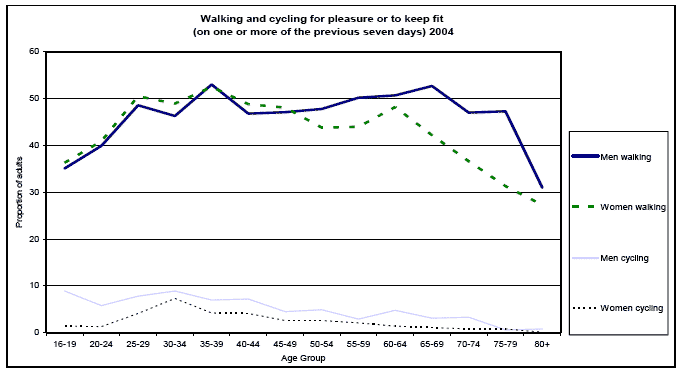
Source: more detailed version of figures in Scottish Transport Statistics 2005 edition (Tables 12.11 and 12.12) and Household Transport in 2004 (Tables 12 and 13)
Publications
Household Transport: some SHS results (Published 2005)
Scottish Transport Statistics (Published 2005)
Travel by Scottish residents: some NTS results (Published 2005)
Web link
Scottish Household Survey
Road Network
There were 54,543 kilometres of public road in Scotland on 1 April 2004.
Scottish Ministers are responsible for the trunk road network, which comprises the motorways and some (but not all) of the main A roads. It accounted for 6% of the total length of the public road network, but carried over a third of all the traffic. Local authorities are responsible for the rest of the public road network.
The chart shows the lengths of road by class and speed limit. Roads with a speed limit of up to 40 mph are described as "built-up"; those with a higher speed limit are "non-built-up". Unclassified roads totalled 25,930 km - almost half the total length of the road network. There were 36,260 km of roads with a speed limit of over 40 mph - about two-thirds of the total network.
The length of motorway (excluding slip roads) has risen from 305 km in 1994 to 383 km in 2004. Over the same period, the total length of the public road network increased by 2,197 km (4%), from 52,346 km in 1994 to 54,543 km in 2004, mainly due to a rise of 1,981 km in the total length of unclassified roads with a speed limit of up to 40 mph.
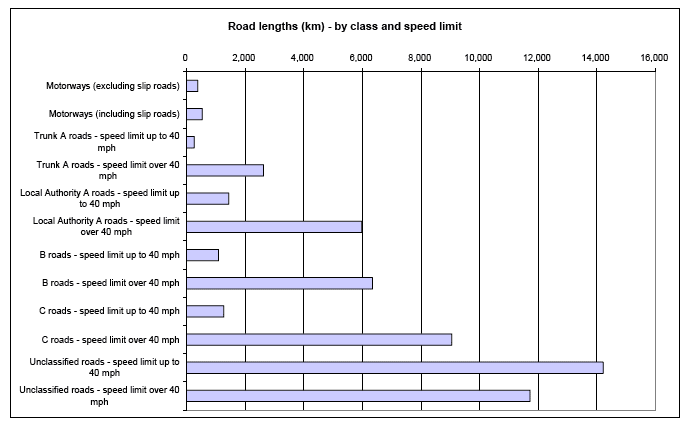
Source: Scottish Transport Statistics 2005 edition (Table 5.1)
Publication
Scottish Transport Statistics (Published 2005)
Web link
Scottish Household Survey
Road Traffic
The total volume of traffic on Scotland's roads was at a record level in 2004: 42,691 million vehicle-kilometres.
Motorways accounted for 14% of all traffic in 2004, trunk A roads for 23%, local authority A roads for 29%, B roads for 9%, C roads for 6% and unclassified roads for 19%.
Cars accounted for 79% of the traffic on Scotland's roads in 2004, light goods vehicles for 12%, heavy goods vehicles for 6%, buses for 1.4%, motorcycles for 0.7% and pedal cycles for 0.5%.
The total volume of traffic on Scotland's roads has risen steadily, with rises of 19% since 1994, 11% since 1997, and 7% since 1999. The slight dip in 2000 was due to the fuel price protests. The volume of traffic on Motorways has grown by 47% since 1994, in part due to the expansion of the Motorway network.
1993 is the first year for which there are figures for the total volume of traffic on Scotland's roads. However, estimates for major roads (Motorways and A roads) are available back to 1983. They show that the volume of traffic on major roads roughly doubled between 1983 and 2004, with growth being more rapid for Motorways than for A roads, due in part to the expansion of the Motorway network.
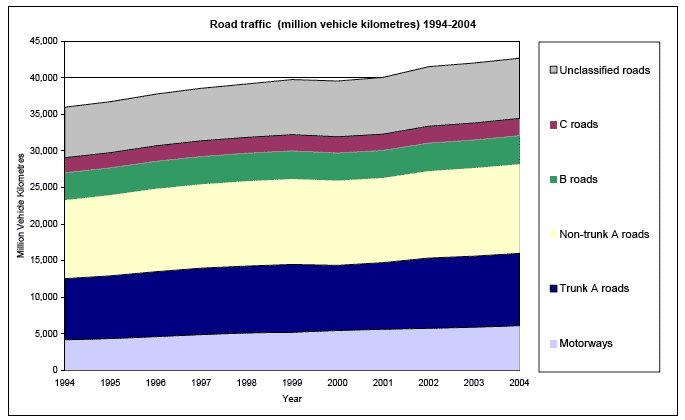
Source: Scottish Transport Statistics 2005 edition (Table 6.1)
Publication
Scottish Transport Statistics (Published 2005)
Road Accident Casualties
In 2004, 306 people were killed on Scotland's roads, 2,742 were recorded as seriously injured and 15,357 suffered "slight" injury. Most of the casualties were travelling in cars (11,549, 167 of whom died), 3,063 were pedestrians (75 were killed), 986 were motorcyclists (41 died) and 773 were pedal cyclists (7 died). There were 2,389 child casualties, of whom 12 died,
There are three national casualty reduction targets for 2010, all based on the 1994-98 "baseline" annual averages: reductions of 40% in the numbers killed or seriously injured, 50% in the number of children killed or seriously injured, and 10% in the slight casualty rate. The relevant figures for 2004 were, respectively, 37%, 55% and 23% below the "baseline" levels, so the first target has almost been achieved, and the second and third targets have been achieved.
Between 1994 and 2004, the number of people killed fell by 16%, seriously injured casualties dropped by 47% and there was an 18% fall in overall casualty numbers. Car casualties fell by 11%, pedestrian casualties by 35% and pedal cyclist casualties by 44%. However, motorcyclist casualties increased by 6%. The number of children killed dropped from 37 to 12, the total number of child casualties fell by 43%, and the number of casualties who were pupils on a journey to or from school fell by 50%, from 830 to 419.
Over the longer term, casualty numbers have fallen considerably from the peak levels of the late 1960s and early 1970s.
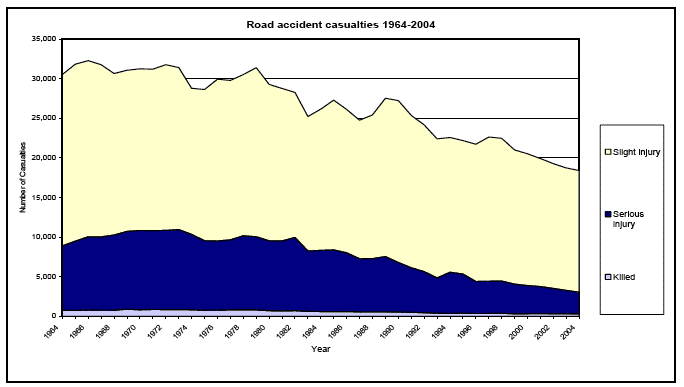
Source: Road Accidents Scotland 2004 (Table 2)
Publications
Road Accidents Scotland (Published 2006)
Key Road Accident Statistics (Published 2005)
Scottish Transport Statistics (Published 2005)
Public Transport
Availability of bus Services
The Scottish Household Survey asks householders about the distance to the nearest bus stop, or place where one can get a bus, and the frequency of service there. In 2004, about 55% of householders said that they were within three minutes walk of a bus stop, 31% that they were within 4-6 minutes walk, 8% within 7-13 minutes walk, 3% said 14 or more minutes, 1% did not know how long it would take to walk to the nearest bus stop, and 1% said that they did not have a bus service.
The chart shows that there were some considerable differences between urban and rural areas: as would be expected, a lower proportion of the population in rural areas lived within a short walk of a bus stop, and a higher percentage of the householders in some of the most remote areas said that they had no bus service.
The householder is also asked about the frequency of service at the nearest stop. 23% did not know what it was, 24% said that there was at least one bus every 13 minutes, 23% said one every 14-26 minutes, 25% said one every 27-63 minutes, and 4% said one every 64 minutes or more. In general, bus services are much less frequent in small towns and rural areas. For example, only 1-4% of householders in small towns and rural areas said they had at least one bus every 13 minutes, compared with 44% in large urban areas and 20% in other urban areas.
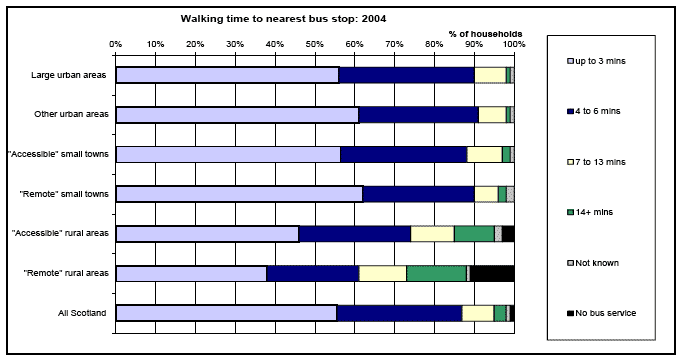
Sources: Scottish Transport Statistics 2005 (Table 2.7), Bus and Coach Statistics 2004-05 (Table 11)
Publications
Bus and Coach Statistics (Published 2006)
Scottish Transport Statistics (Published 2005)
Web link
Scottish Household Survey
Local Bus Services
Local buses are the most frequently used mode of public transport in Scotland. The number of local bus passenger journeys has increased in each of the past six years, from the "all-time low" value of 413 million in 1998/99 to 465 million in 2004-05 (there is a relatively small break in the series between 1998/99 and 1999/00).
These increases follow a long period of decline. There were almost 1,700 million passenger journeys on local bus services in 1960. The number had almost halved by 1975 (when it was 891 million), and the falls continued in most of the following years until the apparent change in trend after 1998/99.
Although many more journeys are made by local bus than by rail, the National Travel Survey shows that the overall total distances which (on average) Scots travel by the two modes are broadly similar, at around 300-400 miles per head per year for each mode. This is because the average journey length is much greater for rail than for local bus.
Relative to the population, more journeys are made on local bus services in Scotland (92 per person per year in 2004-05) than in Great Britain as a whole (79).
The Scottish Household Survey asks adults who have used local bus services in the past month whether they agree or disagree with statements about a range of aspects of the services. In 2004, 72% of people who had used their local bus service in the past month agreed that the buses were on time, 75% agreed that services ran when the person needed them, and 68% agreed that the fares were good value.
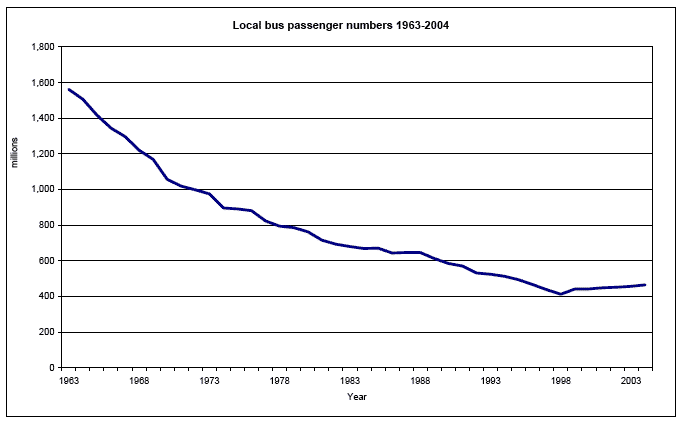
Source: updated version of Scottish Transport Statistics 2005 edition (Table H1) and Bus and Coach Statistics 2004-05 (Table 2.1)
Publications
Bus and Coach Statistics (Published 2006)
Scottish Transport Statistics (Published 2005)
Travel by Scottish residents (Published 2005)
Web link
Scottish Household Survey
Rail Passenger Services
The number of rail passenger journeys originating in Scotland rose to 72.9 million in 2004-05: the highest level for about 40 years (the previous peak was 73.0 million in 1964).
Over the longer-term, rail passenger numbers fell from 73 million in 1964 to a low of 50 million in 1982. Over the next 10-15 years, passenger numbers remained between 50 million and 60 million per year, before rising to 64.9 million in 1999/00. That short-term peak level was followed by lower figures from 2000/01 to 2002/03, due to the effects on services of the post-Hatfield speed restrictions and the ScotRail drivers' pay dispute. Patronage subsequently recovered, with large increases in the latest two years.
The rail punctuality Public Performance Measure for ScotRail (the percentage of services which arrived at their final destination within five minutes of the timetabled time) fell from 93.9% in 1997/98 to just over 82% in 2001/02 and 2002/03 (when services were affected by the post-Hatfield speed restrictions and the drivers' pay dispute); it was 83.1% in 2004/05.
According to the National Passenger Survey, the percentage of ScotRail passengers who were very satisfied or fairly satisfied with their journey fell from 86 % in 1999 to 80% in 2002, before rising to 85% in 2004. The percentage who felt that value for money was "good" was 62% in 1999 and 58% in 2004.
The Scottish Household Survey asks adults who have used train services in the past month whether they agree or disagree with statements about a range of aspects of the services. In 2003, 78% agreed that the trains were on time, 80% agreed that services ran when the person needed them, and 61% agreed that the fares were good value.
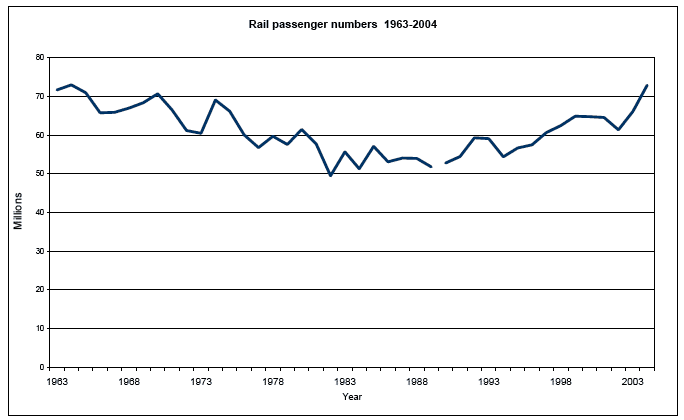
Source: updated version of Scottish Transport Statistics 2005 edition (Table H1)
Publications
Household Transport (Published 2005)
Scottish Transport Statistics (Published 2005)
Web link
Scottish Household Survey
Air Services
There was a record number of air terminal passengers in 2004: 22.6 million. There has been almost continuous growth from 1.2 million in 1960, with increases in all but five of the years since then.
Low-cost airlines have contributed to the rapid growth in recent years. In 2004, more than half the passengers who used Scottish airports were travelling to or from other UK airports - principally London Heathrow (3.9 million), Gatwick (1.6 million), Stansted (1.5 million), Luton (1.2 million), Belfast (0.8 million) and Birmingham (0.8 million). International passenger numbers were greatest for flights to/from Amsterdam (1.0 million), Dublin (0.8 million) and Palma DeMallorca (0.5 million).
Highlands and Islands Airports Ltd ( HIAL) operates 10 airports, which served a total of 930,000 terminal passengers in 2004. Over half of these were at Inverness (520,000); most of the rest were at Stornoway (111,000), Sumburgh (108,000) and Kirkwall (102,000).
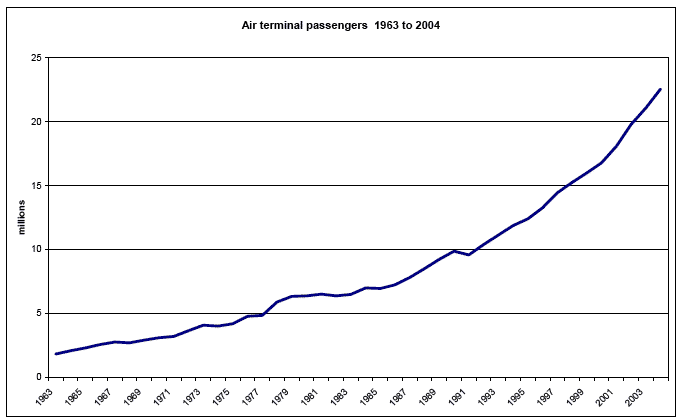
Source: Scottish Transport Statistics 2005 edition (Table H1)
Publication
Scottish Transport Statistics (Published 2005)
Ferry Services
In 2004, CalMac ferries carried about 5.3 million passengers. The most heavily-used routes were: Wemyss Bay - Rothesay (764,000); Ardrossan - Brodick (717,000); Largs - Cumbrae (683,000); Oban - Craignure (653,000) and Gourock - Dunoon (620,000). CalMac services carried a total of 1.1 million cars, the numbers on the the specified routes being: 152,000 for Wemyss Bay - Rothesay; 126,000 for Ardrossan - Brodick; 132,000 for Largs - Cumbrae; 116,000 for Oban - Craignure and 90,000 for Gourock - Dunoon.
There were 2.3 million passenger journeys between Scotland and Northern Ireland in 2004: 1.32 million on the Stranraer - Belfast route, 595,000 on Cairnryan - Larne, 303,000 on Troon - Belfast and 120,000 on Troon - Larne. The numbers of cars carried on these routes (in 2003) were: 239,000 for Stranraer - Belfast ; 139,000 for Cairnryan - Larne, 87,000 for Troon - Belfast and 25,000 for Troon - Larne.
In 2004, 1.3 million people used the Western Ferries Gourock - Dunoon service, which carried 553,000 cars. The Renfrew - Yoker ferry carried 129,000 passengers, and about 70,000 people used the Gourock - Kilcreggan service.
289,000 passengers and 64,000 cars were carried on the NorthWeb link ferry services to and from Orkney and Shetland in 2004. Orkney Ferries intra-island services carried 322,000 passengers and 60,000 cars. 755,000 passenger journeys were made on Shetland Islands Council services in 2004, which carried 315,000 cars.
The Rosyth-Zeebrugge service (which started in May 2002) carried 192,000 passengers in 2004.
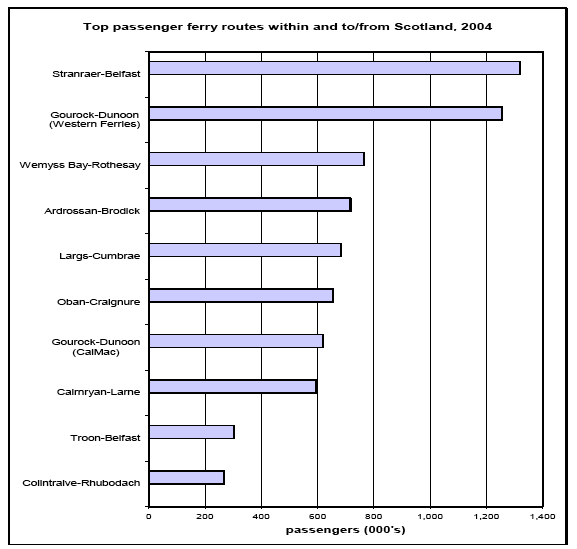
Source: Scottish Transport Statistics 2005 edition (Tables 10.12, 10.14 and 10.15)
Publication
Scottish Transport Statistics (Published 2005)
Travel Information and Concessionary Fares
In 2004, the Scottish Household Survey ( SHS) found that 79% of adults who had used a local bus service in the past month agreed that finding out about routes and times was easy. Similarly, 85% of rail users interviewed in 2003 agreed that finding out about routes and times was easy. However, 23% of all householders interviewed in 2004 said that they did not know the frequency of services at their nearest bus stop.
Traveline Scotland "went live" for telephone calls on 3 January 2001. The number of calls answered has risen rapidly, from 195,000 in 2001 to 585,000 in 2004 (an average of about 1,600 per day).
The Traveline Web site was formally launched on 16 December 2002, and had 1.8 million hits in 2004 (an average of about 4,900 per day). In interviews conducted in 2003 and 2004, the SHS found that 4.4% of adults said that they had telephoned Traveline to get information or advice about travel before making a journey by public transport in the month before the interview.
A national minimum standard of free off-peak local bus travel for elderly and disabled people in Scotland was introduced on 30th September 2002. The figures for the 2003/04 financial year were the first to show the full effects of this, and also the effects of the extension, on 1 April 2003, of the arrangements to men aged 60-64 (who then became eligible to receive the same travel benefits as women aged 60+ and men aged 65+).
The total number of bus journeys made under concessionary fare schemes has increased from about 103 million in 2001/02 to about 145 million in 2004/05. This is expected to increase further, following the introduction of free Scotland-wide bus travel (with no restriction at "peak" times) for elderly and disabled people on 1st April 2006.
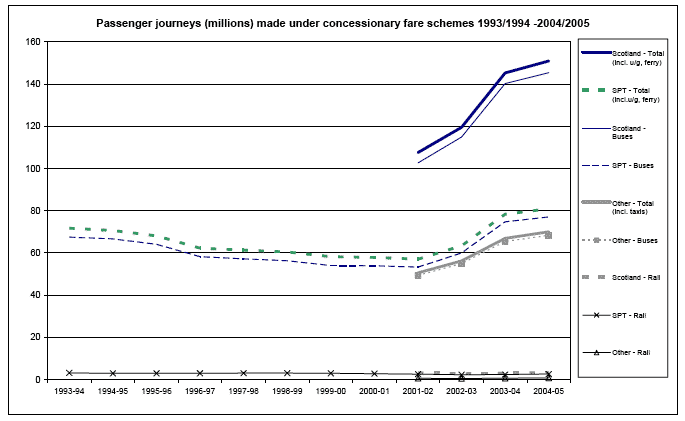
Source: updated version of Scottish Transport Statistics 2005 edition (Table 12.25)
Publication
Scottish Transport Statistics (Published 2005)
Freight Transport
Rail and Freight Weight
Road accounts for the vast majority of freight traffic, when this is measured on a "tonnes lifted in Scotland" basis: generally around 150-160 million tonnes in each year since 1988. The apparent sharp increase in 2004 is thought to be due to a break in the series (following changes to the methodology and processing system of the Department for Transport's Continuous Survey of Road Goods Transport) rather than representing a genuine rise.
Rail freight has increased slightly from the mid-1990s "all-time low", to around 8-10 million tonnes in recent years.
Most road hauls are short-distance. When measured in "tonne-kilometres" (which take account of the distance that the freight is carried, and are unaffected by freight being lifted several times en route), road is around 14-15 billion and rail about 3 billion. (Such figures are available for fewer years - e.g. only from 1996/97 for rail).
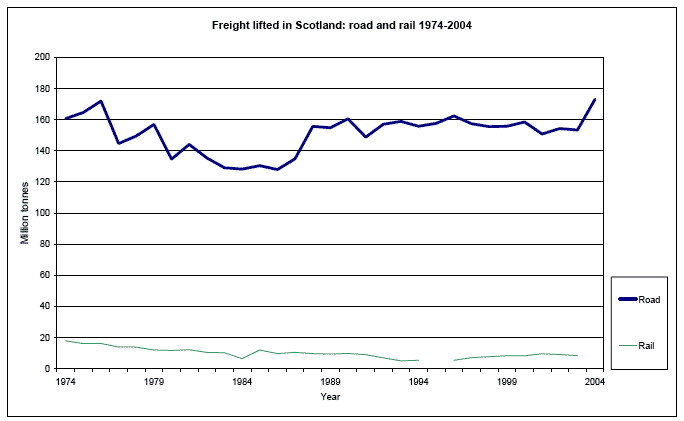
Source: Scottish Transport Statistics 2005 edition (Table H2)
Publication
Scottish Transport Statistics (Published 2005)
Coastwise Shipping Inland Waterways and Pipelines
Following the oil-related increases in the 1970s, the tonnages lifted in Scotland by coastal shipping and pipelines have fluctuated over the past 20 years, and are currently around 25-30 million tonnes each per year. (A new EC Maritime Statistics Directive caused the break in the "coastal shipping" series.) Inland waterway freight has remained fairly stable, around 10-12 million tonnes.
When measured in "tonne-kilometres" (which take account of the distance that the freight is carried, and are unaffected by freight being lifted several times en route), shipping is around 14-15 billion, pipeline roughly 6 billion, and inland waterway _ billion. (Such figures are available for fewer years).
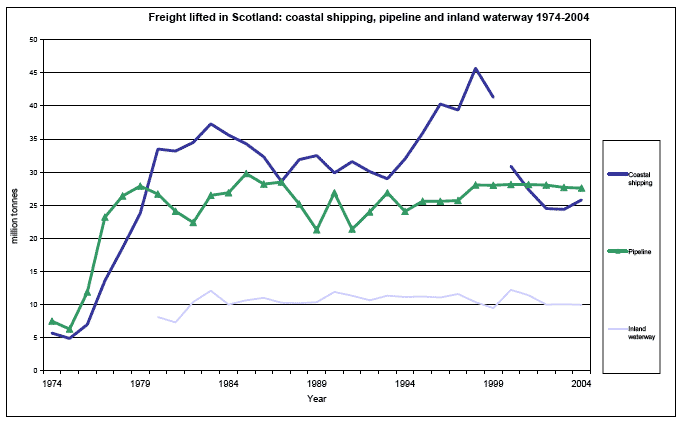
Source: updated version of Scottish Transport Statistics 2005 edition (Table H2)
Publication
Scottish Transport Statistics (Published 2005)
Brief Guide to Transport Publications
Scottish Transport Statistics The Summary describes the trends for each mode of transport over the past ten years, compares some key statistics with the equivalent figures for Great Britain and provides longer-term historical series. The chapters include: Road transport vehicles, Bus and coach travel, Road freight, Toll bridges, Road network, Road traffic, Injury road accidents, Rail services, Air transport, Water transport, Finance, Personal and cross-modal travel and International Comparisons.
Updated versions of Scottish Transport Statistics tables Provide a further year's figures for some of the "key" topics in the publication. Generally, updated tables are provided for topics for which the figures in the printed publication were a year "behind" most of the other figures. For example, the printed edition which appeared in August 2005 showed bus passenger numbers up to the 2003-04 financial year; the updated versions of its tables included the bus passenger numbers for the 2004-05 financial year (plus revisions that the Department for Transport then made to the figures for some earlier years).
Excel Versions of Transport Statistics Tables
Extra road accident statistics tables
Road Accidents Scotland The Summary shows the main trends in the numbers of road accidents and casualties in the past ten years. The commentary provides description of longer-term trends, provides more detailed analyses of the numbers of accidents, motorists and casualties, and compares the Scottish figures with those of other countries. There is also an article on the casualty reduction targets for 2010. The tables cover Accidents, Accident costs, Vehicles involved, Drivers and riders, Drivers breath-tested, Drink-drive accidents and casualties, and Casualties.
Other Transport Statistics publications
- Key Transport Statistics - a six-page card showing key statistics.
- Household Transport - main (non-Travel Diary) Scottish Household Survey ( SHS) results for Scotland as a whole.
- Transport across Scotland - main (non-Travel Diary) SHS results for Local Authority ( LA) areas, with some for Regional Transport Partnership ( RTP) areas.
- SHS Travel Diary results - results for Scotland as a whole, with some for LA and RTP areas.
- Travel by Scottish residents - National Travel Survey results for Scotland
- Bus and Coach Statistics - results of DfT's survey of Public Service Vehicle operators and bus-related results from the SHS.
- Key Road Accidents Statistics - provisional road accident and casualty numbers (which are later superseded by the figures in the Road Accidents Scotland volume).
Web link
Transport Statistics Publications
There is a problem
Thanks for your feedback